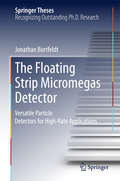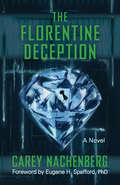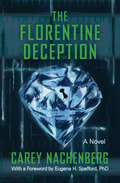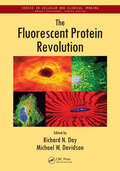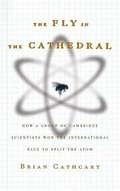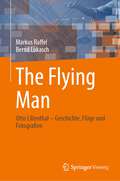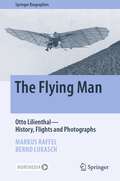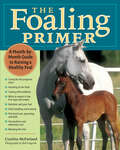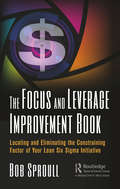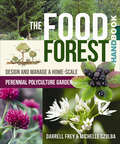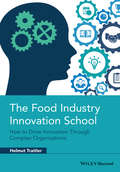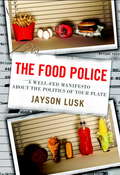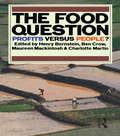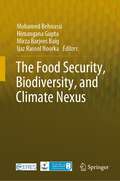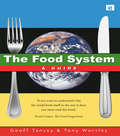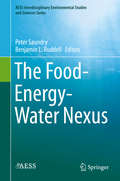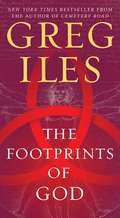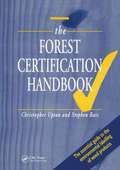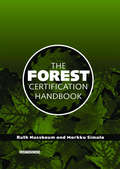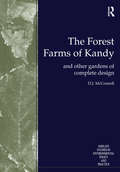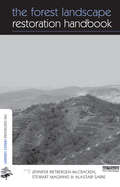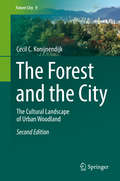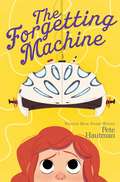- Table View
- List View
The Floating Strip Micromegas Detector
by Jonathan BortfeldtThis book discusses a novel and high-rate-capable micro pattern gaseous detector of the Micromegas (MICRO-MEsh GAS detector) type. It provides a detailed characterization of the performance of Micromegas detectors on the basis of measurements and simulations, along with an in-depth examination of analysis and reconstruction methods. The accurate and efficient detection of minimum ionizing particles in high-rate background environments is demonstrated. The excellent performance determined here for these lightweight detectors will make possible the live medical imaging of a patient during ion-beam treatment.
The Florentine Deception
by Eugene H Spafford Carey NachenbergYou never know what secrets you'll find buried inside an old computerOn a whim, twenty-something cyber-security expert Alex Fife engages in a bit of voyeuristic digital snooping while cleaning up an old PC for a charity. To his surprise, Alex learns that the computer's deceased owner, a shady antiquities smuggler, had been trying to unload a priceless object known as the Florentine on the black market. But with the dealer's death, the Florentine is unaccounted for and potentially ripe for the taking. Hooked by the prospect of solving a mystery, Alex embarks upon a quest through subterranean grottos, freezing morgues, and hidden cellars in search of the Florentine. But what starts out as a seemingly innocuous pursuit quickly turns into a nightmare, as Alex discovers that the Florentine may not be a lost treasure after all, but something far more insidious. A weapon that, in the wrong hands, could bring the developed world to its knees--one that Alex's adversaries will do anything to acquire.Will Alex unlock the secrets of the Florentine in time to prevent a catastrophic attack? Read The Florentine Deception to find out!
The Florentine Deception: A Novel
by Carey NachenbergA seemingly mundane computer cleanup leads to an electrifying quest for an enigmatic--and deadly--treasure in this gripping techno-thriller After selling his dorm-room startup for millions and effectively retiring at the age of twenty-five, Alex Fife is eager for a new challenge. When he agrees to clean up an old PC as a favor, he never expects to find the adventure of a lifetime waiting for him inside the machine. But as he rummages through old emails, Alex stumbles upon a startling discovery: The previous owner, a shady antiques smuggler, had been trying to unload a mysterious object known as the Florentine on the black market. And with the dealer's untimely passing, the Florentine is now unaccounted for and ripe for the taking. Alex dives headfirst into a hunt for the priceless object. What starts out as a seemingly innocuous pursuit quickly devolves into a nightmare when Alex discovers the true technological nature of the Florentine. Not just a lost treasure, it's something far more insidious: a weapon that could bring the developed world to its knees. Alex races through subterranean grottos, freezing morgues, and hidden cellars in the dark underbelly of Los Angeles, desperate to find the Florentine before it falls into the wrong hands. Because if nefarious forces find it first, there'll be nothing Alex--or anyone else--can do to prevent a catastrophic attack.
The Fluorescent Protein Revolution
by Vijay K. Vaishnavi William KuechlerAdvances in fluorescent proteins, live-cell imaging, and superresolution instrumentation have ushered in a new era of investigations in cell biology, medicine, and physiology. From the identification of the green fluorescent protein in the jellyfish Aequorea victoria to the engineering of novel fluorescent proteins, The Fluorescent Protein Revoluti
The Fly Who Flew to Space
by Lauren SánchezFlynn is a little fly with big dreams. School isn’t easy for Flynn, and they daydream of becoming an astronaut. One day while exploring a nearby rocket company they stumble onto a rocket ship and into the biggest adventure of their life. <P><P> Young readers will be introduced to early space concepts such as atmosphere and G-Force while being introduced to Earth’s amazing natural wonders, all while being reminded that big dreams and a curious mind can lead to the most astonishing discoveries. <P><P> Emmy-award winning journalist, pilot and philanthropist Lauren Sanchez takes readers on a high-flying space adventure with Flynn the Fly in her picture book debut. Inspired by her childhood battle with dyslexia and a lifelong love of flying, The Fly Who Flew to Space will have little readers learning about early STEM concepts and reaching for the stars. <P><P><i>Advisory: Bookshare has learned that this book offers only partial accessibility. We have kept it in the collection because it is useful for some of our members. Benetech is actively working on projects to improve accessibility issues such as these.</i> <p> <b>New York Times Bestseller</b>
The Fly in the Cathedral
by Brian CathcartThis book describes how a group of Cambridge scientists won the international race to split the atom.
The Flying Man: Otto Lilienthal – Geschichte, Flüge und Fotografien
by Markus Raffel Bernd Lukasch"Von allen Männern, die sich im 19. Jahrhundert mit dem Problem der Fliegerei beschäftigten, war Otto Lilienthal mit Abstand der bedeutendste. Seine Größe zeigte sich in jeder Phase des Problems. Niemand kam ihm gleich in der Fähigkeit, neue Mitstreiter für die Sache zu gewinnen; niemand kam ihm gleich in der Fülle und Tiefe des Verständnisses der Prinzipien des Fliegens; niemand tat so viel, um die Welt von den Vorteilen gekrümmter Flügeloberflächen zu überzeugen; und niemand tat so viel, um das Problem des menschlichen Fluges in die freie Luft zu verlegen, wo es hingehörte."Diese Worte stammen von Wilbur Wright, der 1903 zusammen mit seinem Bruder Orville auf den Sanddünen der Outer Banks vor der Küste North Carolinas den ersten Motorflug erfolgreich absolvierte. Wilbur sprach dabei über den bedeutendsten ihrer Vorgänger, Otto Lilienthal.Lilienthal erregte weltweites Aufsehen durch die spektakulären Fotos, die ihn im Flug zeigten und die durch eine Technologie ermöglicht wurden, die er gerade erst entwickelt hatte. Diese zufällige Verbindung zwischen einem Pionier der Luftfahrt und den Pionieren der so genannten "Moment- oder Augenblicksfotografie" ist verantwortlich für die immense zeitgenössische Popularität von Lilienthals Flügen rund um den Globus, den ersten Freiflügen eines Menschen überhaupt. Dieses Buch zeichnet das Leben des deutschen Luftfahrtpioniers nach und konzentriert sich dabei auf die Konstruktionen seiner zahlreichen Flugzeuge und die erhaltene fotografische Dokumentation. Die Darstellung endet mit einem bemerkenswerten Forschungsprojekt, das einer der Autoren bis hin zu eigenen Übungsflügen mit Lilienthals "Normalsegelflugapparat" und "großem Doppeldecker" durchgeführt hat. Dieses Projekt bot neue Einblicke in Lilienthals Arbeit und führte auch zu einer spektakulären Luftbegegnung von Lilienthals Doppeldecker von 1895 und dem Doppeldecker der Gebrüder Wright von 1902 an einem historischen Ort auf den Outer Banks. Das Buch bietet Zugang zu Videomaterial, das größtenteils im Rahmen dieses Projekts entstanden ist.
The Flying Man: Otto Lilienthal, the World's First Pilot
by Mike DownsHere is the little-known history of Otto Lilienthal, a daring man whose more than 2,000 successful flights inspired the Wright Brothers and other aviation pioneers.In 1862, balloons were the only way to reach the sky. But 14-year-old Otto Lilienthal didn&’t want to fly in balloons. He wanted to soar like a bird. Scientists, teachers, and news reporters everywhere said flying was impossible. Otto and his brother Gustav desperately wanted to prove them wrong, so they made their own wings and tried to take flight. The brothers quickly crashed, but this was just the beginning for Otto, who would spend the next 30 years of his life sketching, re-sketching, and building gliders. Over time, Otto&’s flights got longer. His control got better. He learned the tricks and twists of the wind. His flights even began to draw crowds. By the time of his death at age 48, Otto had made more than 2,000 successful glider flights. He was the first person in history to spend this much time in the air, earning the title of the world&’s first pilot and paving the way for future aviation pioneers.
The Flying Man: Otto Lilienthal—History, Flights and Photographs (Springer Biographies)
by Markus Raffel Bernd Lukasch"Of all the men who attacked the flying problem in the 19th century, Otto Lilienthal was easily the most important. His greatness appeared in every phase of the problem. No one equaled him in power to draw new recruits to the cause; no one equaled him in fullness and dearness of understanding of the principles of flight; no one did so much to convince the world of the advantages of curved wing surfaces; and no one did so much to transfer the problem of human flight to the open air where it belonged." These words were spoken by Wilbur Wright, who successfully accomplished the first powered flight together with his brother Orville in 1903 on the sand dunes of the Outer Banks off the coast of North Carolina. Wilbur was talking about the most important of their predecessors, Otto Lilienthal. Lilienthal attracted worldwide attention due to the spectacular photographs showing him in flight, made possible by technology that had only just been developed by him. This fortuitous union between a pioneer of aviation and the pioneers of so-called “instantaneous photography” is responsible for the immense contemporary popularity of Lilienthal’s flights around the globe, the first ever free flights performed by man. This book traces the life of the German aviation pioneer, focusing on the designs of his many aircraft and the photographic documentation that has survived. The presentation ends with a remarkable research project conducted by one of the authors, right up to and including his own training exercises with Lilienthal’s “normal soaring apparatus” and “large biplane”. This project offered new insight into Lilienthal’s work, and also led to a spectacular aerial meeting of Lilienthal's 1895 biplane and the Wright brothers’ 1902 biplane at a historic location on the Outer Banks. The book provides access to video material, largely stemming from this project.
The Foaling Primer: A Step-by-Step Guide to Raising a Healthy Foal
by Cynthia McFarlandStart your foal off on the right hoof! With correct handling, health care, and training during the first year, you can establish a strong foundation that will benefit your horse throughout his life. From bottle feeding to rope leading, Cynthia McFarland covers everything you need to know as you guide your foal from birth to yearling. With an emphasis on recognizing critical developmental signs, McFarland’s expert advice will help you raise a healthy, happy, and well-adjusted foal.
The Focus and Leverage Improvement Book: Locating and Eliminating the Constraining Factor of Your Lean Six Sigma Initiative
by Bob SproullCompanies all over the world try their best to improve their business by implementing efforts such as Six Sigma, Lean Manufacturing, or a combination of the two methodologies. Logic would tell you that these two methods would be the right approach because you would have an improvement method that, through Lean, reduces waste and make value flow, while Six Sigma reduces and controls variation. If this were true, then why is it that many of these initiatives simply aren’t delivering quantifiable bottom-line results? After having studied many of these on-going improvement efforts, the author believes that these efforts are missing an important focusing mechanism. That is, most of these improvement efforts attempt to improve "everything" rather than finding that key part of the system that should be assessed and improved, the constraining factor, and then focusing the improvement efforts there and only there. The hallmark of this book is how to first locate this constraining factor and then determine the best way to exploit it to generate extreme profits, radically improve on-time delivery of products or services and increase market share by outperforming your competition at rates you never expected possible. How do we do this? By combining Lean and Six Sigma with the Theory of Constraints. This book demonstrates both the basics of improvement (i.e. results) with the "how to" (i.e. the methodology) in a very simple format that everyone within your organization will understand.
The Food Forest Handbook: Design and Manage a Home-Scale Perennial Polyculture Garden
by Darrell Frey Michelle CzolbaLearn how to mix and match plants in unique combinations to establish bountiful landscapes and create genuine self-reliance in years to come.A food forest is a productive landscape developed around a mix of trees and perennials. Rooted in permaculture principles, this integrated approach to gardening incorporates a variety of plants such as fruit and nut trees, shrubs, vines, and perennial herbs and vegetables. Food forests can help increase biodiversity, protect valuable habitat for beneficial insects, and promote food security and resilience, all while providing an abundant harvest.The Food Forest Handbook is a practical manual for the design and management of a home-scale perennial polyculture garden. Simple, straightforward instructions guide the reader through:Getting started—site assessment and planningTending the forest garden—maintaining soil health, succession planning, mulching, pruning and moreThe fruits of your labor—crop profiles, harvest, storage, nutrition and recipesThis timely book makes the concept of food forests accessible to everyone, offering a unique approach to low-maintenance, high-yield, sustainable food production.“What happens if we were to drop the boundary between the built environment and nature? Wouldn’t we all be much better off? The Food Forest Handbook guides our first steps along that path.” —Albert Bates, author of The Biochar Solution“Through this in-depth practical book you will learn the strategies for effective planning, design, establishment and management of perennial polycultures . . . I recommend this book to all those who are bringing diversity to their planting schemes.” —Jude Hobbs, permaculture land-use consultant, designer, and educator, Cascadia Permaculture
The Food Industry Innovation School
by Helmut TraitlerInnovation and new product development are increasingly perceived as drivers of profits in the food industry. Companies are dedicating a large amount of resources to these areas and it is crucial that individuals understand how to be part of this new strategy. Food Industry Innovation School focuses on key skills needed to drive new ideas from initial concepts through to successful products on the shelf. The author argues that any individual can learn how to lead innovation within complex organizations utilizing companies? commercial and financial resources. The book focuses on the impact of single individuals on company successes. Case studies from the marketplace provide valuable examples of accomplishments and failures. Product development involves a plethora of activities such as R&D, innovation, engineering, packaging and design, manufacturing, logistics and supply chain management, as well as marketing, sales and finance, and the book addresses all these crucial functions undertaken by food companies and manufacturers of other packaged consumer goods. The learning principles and examples (based on the author?s personal experience) are valid in many fast-moving consumer goods organizations and so the principles, best practices and solutions offered in the 12 chapters are relevant to a wide audience in the food industry and beyond, including those working in household products, retail, the automotive industry, computers and IT, furniture, and even media and publishing.
The Food Police
by Jayson LuskA rollicking indictment of the liberal elite's hypocrisy when it comes to food.Ban trans-fats? Outlaw Happy Meals? Tax Twinkies? What's next? Affirmative action for cows? A catastrophe is looming. Farmers are raping the land and torturing animals. Food is riddled with deadly pesticides, hormones and foreign DNA. Corporate farms are wallowing in government subsidies. Meat packers and fast food restaurants are exploiting workers and tainting the food supply. And Paula Deen has diabetes! Something must be done. So says an emerging elite in this country who think they know exactly what we should grow, cook and eat. They are the food police. Taking on the commandments and condescension the likes of Michael Pollan, Alice Waters, and Mark Bittman, The Food Police casts long overdue skepticism on fascist food snobbery, debunking the myths propagated by the food elite. You'll learn:- Organic food is not necessarily healthier or tastier (and is certainly more expensive).- Genetically modified foods haven't sickened a single person but they have made farmers more profitable and they do hold the promise of feeding impoverished Africans.- Farm policies aren't making us fat.- Voguish locavorism is not greener or better for the economy.- Fat taxes won't slim our waists and "fixing" school lunch programs won't make our kids any smarter.- Why the food police hypocritically believe an iPad is a technological marvel but food technology is an industrial evilSo before Big Brother and Animal Farm merge into a socialist nightmare, read The Food Police and let us as Americans celebrate what is good about our food system and take back our forks and foie gras before it's too late!
The Food Question: Profits Versus People
by Maureen Mackintosh Henry Bernstein Charlotte MartinWasteful over-consumption (by some) in the developed countries and the continuing, in some cases worsening, hunger of millions in the Third World is a dramatic indication that food problems are urgent. Anger is not enough and this book, which comes from the research group on Development Policy and Practice in the Open University (DPP), aims to provide some of the analytical tools needed for serious action. Case studies to show ways in which food aid has been used by donor countries for political ends; descriptions of the relationships between markets and human needs; articles on the problems associated with the feminization of poverty; pieces on patterns and trends of food production; analysis of land reform; an evaluation of the effects of biotechnology are all part of this rich and lively collection of articles written specially for this book.
The Food Security, Biodiversity, and Climate Nexus
by Mohamed Behnassi Himangana Gupta Mirza Barjees Baig Ijaz Rasool NoorkaThis volume is the outcome of an international cooperation between 73 scientists, experts, and practitioners from many countries, disciplines, and professional areas. As a part of a series of CERES publications, the volume attempts to contribute to the scientific debate about the food–biodiversity–climate nexus by developing a comprehensive region-specific and broader global understanding of the linkages between these areas, especially in the context of Global South. Instead of providing only modern science-based solutions for the nexus related challenges, the volume covers case studies that present mixed solutions, offering the use of traditional ecological knowledge in combination with modern science for both resilience and sustainability. This is increasingly instrumental in shaping the needed response options regarding the economic, social, and environmental future of the world. Based on a multi-regional and cross-sectoral analysis, the approach consists of: assessing the different natural and anthropogenic factors currently affecting ecosystems and their services, especially the impacts of climate change; highlighting the different linkages between the state of biodiversity and food systems in many contexts and scales; and exploring the various response mechanisms to effectively manage the implications of such linkages. Most chapters provide inputs for future relevant research and policy agendas.
The Food System
by Geoff Tansey Anthony WorsleyFood is a massive industry and the many key players involved have very different interests. In wealthy nations those interests can range from corporate survival and maintaining profitability in a market with limited demand, to promoting a healthy diet and ensuring food safety. For the poor, the emphasis is all too often on simply getting enough to eat. As information technology and biotechnology are set to revolutionize the food system, it is essential to understand the broad context in which the different actors operate, so that all the world's people can enjoy a safe, secure, sufficient and sustainable food supply. This text provides an overview of today's dominant food system - one developed in and controlled by northern industrialized countries, and one that is becoming increasingly globalized.
The Food-Energy-Water Nexus (AESS Interdisciplinary Environmental Studies and Sciences Series)
by Peter Saundry Benjamin L. RuddellThis will be the first textbook on the integration of food, energy and water systems (FEWS). In recent years, the world has seen a dramatic rise in interdisciplinary energy and environmental courses and degrees at the undergraduate and graduate levels. In the US for instance, the number and variety of such programs has increased significantly over the past decade, Simultaneously, national and international initiatives that integrate food, energy and water systems have been launched. This textbook provides a substantive introduction to the food-energy-water nexus suitable for use in higher level undergraduate and graduate level courses and for scholars moving into the field of nexus studies without a strong background in all three areas and the many aspects of nexus studies.
The Footprints of God: A Novel (Bride Series)
by Greg IlesThis "alarming, believable, and utterly consuming" (bestselling author Dan Brown) thriller from the New York Times bestselling author of the Natchez Burning trilogy and the Penn Cage series explores the terrifying possibility that the next phase of human evolution may not be human at all...Trinity. The government's top-secret supercomputer is an intelligence beyond comprehension—and a nightmare beyond humanity's worst fears. At the heart of a maelstrom of limitless science and ruthless ambition, Dr. David Tennant, Project Trinity's ethicist, harbors a lethal secret: he knows who murdered a fellow scientist. Fleeing for his life alongside psychiatrist Rachel Weiss, the only hope for survival lies in revealing the shocking connection between Trinity's apocalyptic power and David's tortured mind. Mankind's future hangs in the balance—and the price of failure is extinction.
The Forest Certification Handbook
by Christopher UptonFrom forester to retailer, stakeholders in the industry are under increasing pressure to assure customers that their wood products have come from well managed, sustainable forests. The Forest Certification Handbook gives practical advice on developing, selecting and operating a certification programme which provides both market security and raises standards of forestry management. It provides a thorough analysis of all the issues surrounding certification, including the commercial benefits to be gained, the policy mechanisms required, the interpretation and implementation of forestry management standards, and the process of certification itself. Three unique directories give details of currently certified forests, international and national initiatives, and active certification programmes.
The Forest Certification Handbook (The Earthscan Forest Library)
by Markku Simula Ruth NussbaumFirst published in 1995, The Forest Certification Handbook has become the landmark book concerning all aspects of forest and wood product certification from policy to business to in-the-field technical issues. Yet since first publication an enormous amount has happened in the field. This new second edition has been entirely rewritten to incorporate the changes over the past decade, and is a complete and up-to-date source of information on all aspects of developing, selecting and operating a forest certification programme that provides both market security and raises standards of forest management.
The Forest Farms of Kandy: and Other Gardens of Complete Design (Routledge Studies in Environmental Policy and Practice)
by D.J. McConnell K.A.E. Dharmapala S.R. AttanayakeThroughout the tropical world, especially in South and Southeast Asia, tropical America, Africa and Oceania, there exists a range of forest garden farming systems. These are small, low-input, but productive and sustainable family units of highly diversified trees, palms, bushes and vines, with few conventional field crops or livestock. Providing a survey of these systems around the world and an in-depth analysis of the farms around Kandy, Sri Lanka, this book offers an economic and ecological description and evaluation of this ancient agroforestry system and its relationship to a wide range of global agro-development and environmental problems. Guided by a table that lists some 30 socio-economic and social criteria by which all farming systems can and should be evaluated, the book presents persuasive evidence supported by comprehensive references. It also examines historical and archaeological findings in order to assess the role these tropical forests played in the general adoption of agricultural farming.
The Forest Landscape Restoration Handbook (The\earthscan Forest Library)
by Stewart Maginnis Jennifer Rietbergen-McCracken Alastair SarreForest loss and degradation have caused a decline in the quality of ecosystem services around the world. But fixing the problem takes more than just planting trees; practitioners increasingly realize that a landscape approach is essential. This handbook, authored and edited by international authorities in the field of forestry, is the first practical guide to using forest landscape restoration (FLR) to repair the damage done to forest lands by poor land management practice. Using research backed by respected institutions such as ITTO and the World Conservation Union (IUCN), it explains how to increase the resilience of landscapes and the communities they support through FLR. The main aim of FLR is not to re-establish pristine forest, even if this were possible; rather, the objective is to make landscapes more resilient and thereby keep future management options open. It also aims to support communities as they strive to increase and sustain the benefits they derive from land management. This book explains the concept of FLR and guides the reader through the steps that must be taken to put it into practice. It is an indispensable aid for practitioners in all aspects of forestry and natural resource management.
The Forest and the City: The Cultural Landscape Of Urban Woodland
by Cecil C. KonijnendijkAmsterdamse Bos, Bois de Boulognes, Epping Forest, Hong Kong’s country parks, Stanley Park: throughout history cities across the world have developed close relationships with nearby woodland areas. In some cases, cities have even developed – and in some cases are promoting – a distinct ‘forest identity’. This book introduces the rich heritage of these city forests as cultural landscapes, and shows that cities and forests can be mutually beneficial.Essential reading for students and researchers interested in urban sustainability and urban forestry, this book also has much wider appeal. For with city forests playing an increasingly important role in local government sustainability programs, it provides an important reference for those involved in urban planning and decision making, public affairs and administration, and even public health. From providers of livelihoods to healthy recreational environments, and from places of inspiration and learning to a source of conflict, the book presents examples of city forests from around the world. These cases clearly illustrate how the social and cultural development of towns and forests has often gone hand in hand. They also reveal how better understanding of city forests as distinct cultural and social phenomena can help to strengthen synergies both between cities and forests, and between urban society and nature.
The Forgetting Machine
by Pete HautmanPeople all over Flinkwater are losing their memories--and it's up to Ginger to figure out what's going on--in this sequel to the "quirky, dryly funny" (Booklist) The Flinkwater Factor from National Book Award-winning author Pete Hautman.Absentmindedness in Flinkwater, a town overflowing with eccentric scientists and engineers, is nothing new. Recently, however, the number of confused, forgetful citizens has been increasing, and no one seems to know why. Ginger Crump figures it's none of her business. She has her own problems. Like the strange cat that's been following her around--a cat that seems to be able to read. And the report for school due Monday. And the fact that every digital book in Flinkwater has been vandalized by a fanatical censor, forcing Ginger to the embarrassingly retro alternative of reading books printed on dead trees. But when Ginger's true love and future husband Billy Bates completely forgets who she is, things suddenly get serious, and Ginger swings into action.
